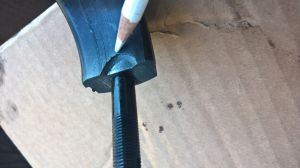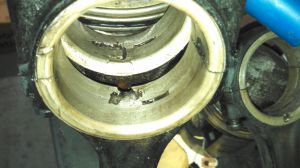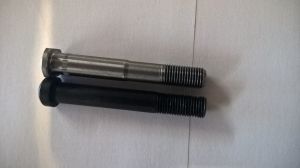- Home
- About Us
- Join/Renew
- Member Benefits
- Member Pages
- Log In
- Help
- Museum Store
I pulled the rods out of the spare long stroke 8 I have and all but one of them had a finger nail or half moon chip out of them on the parting line.
They were on both the rod side and the cap side and are on both the cam and water jacket sides. So there is no pattern.
Back in my tier one auto manufacturing days we used to conduct
Failure Mode and Effects Analysis, basically looking at the part and figuring why it failed.
I am clueless on this one. Anyone have tribal knowledge that can help explain this?
The mains I have checked so far, look good.
Thanks,
Bewildered BIll

Were any of the chips in the oil pan? Any evidence of excessive heat or over-torquing?
I haven’t done a pan inspection, but based on the chip location, they would have been retained in the rod bearing. There was some difference in the torque required to remove the rod bolts. No evidence of heat.
The differences in torque are probably the result of the installer having to match the notches in the castle-nut to the hole in the rod bolt. Often torquing to a minimum acceptable value will have the notch in the nut miss the hole in the bolt.. reducing the torque is not an option.
Torquing further to match the notch to the hole for the insertion of a cotter pin often will result in 5-10 ftlbs more torque than the minimum value..
I’ve found dozens of connecting rods with large pieces of babbitt missing. Very rarely are the missing pieces found.. My belief is that the loose piece is not protected by the film of lubricting oil, since it is loose, and oil can get behind the loose piece, as easy as it can stay between the rod journal and the babbitt piece..
So the piece of babbitt wears away, and is not found..
I have found a few connecting rods with a chunk of babbitt that got loose, that was on the edge of the bearing area, and then was forced out the edge gap of the bearing and the rod journal. The loose piece is wedged and melted against the rod or rod cap.
The old babbitt gets brittle, developed small cracks that become larger until the bearing starts to separate into loose pieces, no longer bonded to the rod or rod bap.. I have also seen large percentages of rod babbitt loose and floating on the rod.. it almost looks like n insert bearing. with side thrust cheeks.
Greg Long

Greg, that picture is scary looking.
Did the engine make any unusual noises when it was running with the bearing surfaces looking like that?
Greg,
I noticed the nuts required different forces to get them loose. Some “cracked”” others just unscrewed. I guess self locking nuts would be in order.
Bill”
Never saw rods chipped like that; have seen many old thick-Babbitt bearings like those. Thick Babbitt has lower strength and there can be problems with the initial bond as well as it starting to disbond and break up late in life. Sometimes pieces of main Babbitt find their way into the crank oil passages and into the rod bearings and rod passage to the wrist pin; sometimes the oil pan, sometimes smeared on the rest of the bearing, just as Greg said.
I have seen bearings with these defects run a long time undetected and I have even seen the time when the men would be forced to get one which had previously been discarded, blend out the edges of the failure, and run it, because they had no choice.
These are large engines not car engines, of course, but similar principles etc. as they were designed and built in the same era.
Greg,
The fact the mains bolts have the heads drilled probably means they have more accurate torque settings
Bill
Hi guys..
I think this set of rods is out of a ’33 engine. The rods did not make a lot of noise, since the oil clearance was not so wide that a heavy oil was unable to maintain an oil film and cushion.. But with between .003″-.0045″ the oil clearance was pretty significant. I did not run this engine long, because there was one rod that would start knocking pretty loudly once the engine reached normal water temperature, and the oil pressure had dropped below 50 psi.
Now, what is interesting, is that the connecting rod that was knocking, did NOT have any chunks missing, but it did have .008″ of oil clearance.. a few scores in the babbitt and rod journal, but nothing excessive.. Only the inside and outside micrometers told the story..
In the photo I posted above, in the background, there is a connecting rod that you can see the hunk of loose babbitt is being forced out the side of the rod, through the side-clearance space. I think all the other bits of missing babbitt got ground away by being forced against the rod journal by oil pressure behind the loose piece of babbitt.
The connecting rod bolts can be drilled, or not. Most are drilled in my experience. Those that are not, have a thin lock nut added, instead of a cotter pin through the drilled hole/castle nut.
It is a good idea to carefully inspect the bolts for indications of stretching, measure the shaft of the bolt, and the diameter of the threads too. Often the bolt and threads will be stretched in the middle, getting narrower, like an hour-glass. Bolts that exhibit stretching should be replaced..
I know that there are modern, high quality bolts available, I think Bill Morris said he found a Jaguar rod bolt that was identical.. hopefully he will post on this thread..
Randy, I’ve seen more rods chipped than not. Especially on the 8’s and 12’s. The Series 80 engines usually don’t have as many chunks of babbitt missing, but have plenty of fractures in the babbitt, and have a lot more scores in the bearing surfaces.. I think the ’20’s oil filtration if any was not as good as the system that was used on the 1929 8 cylinder engines.
Bill, with the main bearing caps on the 8’s having bolts instead of drilled studs , you are correct, the odds favor having the mains torqued more consistently, Providing proper lubrication is used equallly on the bolt threads, and washer /bolt head surfaces. Lubrication is key to getting proper torque readings and properly tight bearing caps..
Just a note on torque, the actual forque setting is actually irrelevant, IF, and only IF you can measure the bolt or stud stretch.. That sounds odd, right?? well the use of a twisting pressure or torque on a nut on a head bolt, or a nut on a connecting rod bolt, is nothing but a way to extrapolate how much the fastener, the bolt or the stud, is being stretched, resulting in clamping pressure of a head gasket, or clamping the rod cap to the rod. Just visualize a ‘C’ clamp in place of each fastener, you need to know how tightly you are holding the parts of the engine together, the only way to know is to know the tensile strength of a fastener’s metal alloy, and how much that type of alloy needs to be stretched to create the needed clamping force..
Once you know the stretch needed for the fastener, then using a torque table for the fastener’s diameter and pitch of threads, the engine designers can figure out what twisting torque on the nut/bolt’s threads will result in stretching the fastener the correct amount..
IF the threads are rusty, or not lubricated with proper lubricants, then the twisting force will be used to some extent to overcome friction in the threads, and not used to stretch the fastener..
That was a long winded way to say: use proper lubricants for bolts and nuts to be torqued.. Anti-seize lubricants usually work best for torquing rods and mains..
When ever I inspect the babbitt in one of our 70-100 year old engines, I expect to find cracked babbitt, just like pot metal parts, the babbitt tends to shrink or swell, and develop cracks and failures of the bond to the steel rod or brass main bearing backing plates.
Main bearings tend to hold up a lot better, due to less direct hammering on the babbitt like a connecting rod has to endure.
I hope all the above makes sense,
Greg Long
Greg,
The Jaguar rod bolt was for a Mk. 9 3.8 liter. I had some stretched bolts on my V-12 when I overhauled it and I found that the Jaguar bolts worked fine. Make sure that you mike the thickness.
Bill
Thanks Greg and Bill
The Jaguar part number is C32344 and ARP makes a set. I have one on order for comparison.
Here is one supplier. I like these as they are one diameter, some others are stepped. The length looks correct.
Always fun to theorize. Bill, for your rods if they are that consistent around the parting line I would suspect that when the babbitt was applied there was a slight contamination around the rod bolt holes, that spread to the nearby surfaces. Studebaker engineer Stanwood Sparrow noted that all it took to ruin a complete batch of babbitt was a single copper washer dropped in by mistake, i.e. pretty sensitive to contaminants.
I think he also noted that usually the babbitt did not fail near top dead center or bottom dead center where the loads tend to be the highest but typically about 45 degrees off where the loads would reverse from compression to tension (combinations of pressure loads and inertias throw then off from straight up and down).
Greg’s bearings look like they failed right at top dead center, which would imply the engine was lugged at high throttle low rpm with hot oil. That is the scenario of driving the car at highway speeds getting everything good and hot minimizing oil viscosity, then stopping and reaccelerating with a high throttle low rpm (lugging). Hot oil, high torque + low RPM is the most likely combination to break through the oil film at TDC. Its where multi-vis is an advantage.
Jim
On further thought one should take the more obvious choice, if the nuts came loose without 40+ ft-lbs torque they were probably not torqued high enough. That would allow the caps to part slightly at high speed near top dead center with throttle closed at the beginning of the intake stroke and pound the babbitt at the parting line when they snapped back together.
Jim
Here is a side by side comparison of the PA rod bolt(black)and the Jaguar one (silver).
Main difference is the main body of the Jag bolt is .375″ while the Pierce is .372″. Is .003 too much interference or should the hole be reamed? The Pierce bolt is just a push fit, the Jag would require force.
The Jag also is tapered down to .350″ from the middle to the start of the threads, then goes out to the .374″ threaded end diameter, same as the Pierce. Threads are the same.
Under head bolt length is 2.5″ for the Jag and 2.575″ for the Pierce. There is no cotter pin hole to line up on the Jag bolt, so I guess thread locker might be in order although I have heard some say torque alone is all that is required.
It also looks like the flat, to keep the bolt from turning, on the head of the Jag bolt is wider(thicker) than the Pierce and will probably have to be ground down.

One last thing. They both weigh 1.4 oz.
I had some Pierce bolts that measured .373 and they were a little sloppy in my V-12 rods. The Jag bolts were .375 as you say and they fit my rods just fine with just a light tap on them to seat them in the rod.
Bill
Bill,
Thanks for the input. I don’t like hammering on things that are hard to replace. Did you have to alter the flats on the head or is there enough clearance?
Bill
The flats fit the rods just fine. I really didn’t have to hammer them in. With a little oil on them they slid in most of the way and I just tapped the heads a couple time to seat the bolt all the way down.
Bill [Lyons], have you tried inserting one of the new bolts in the rod?? .375″ is as I ‘m sure you know, 3/8″. The rods are probably drilled at .375″, and might have some dirt in the bores.. I’ll bet that just passing a 3/8″ bit through the rod’s bolt holes will just clean up the original bore, and not remove much if any metal..
Greg Long
